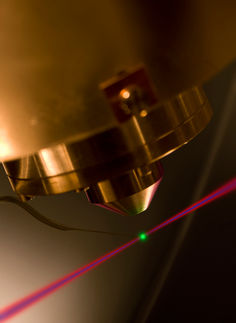Ultrafast lasers give CU-Boulder researchers a snapshot of electrons in action
In the quest to slow down and ultimately understand chemistry at the level of atoms and electrons, University of Colorado at Boulder and Canadian scientists have found a new way to peer into a molecule that allows them to see how its electrons rearrange as the molecule changes shape.
Understanding how electrons rearrange during chemical reactions could lead to breakthroughs in materials research and in fields like catalysis and alternative energy, according to CU-Boulder physics professors and JILA fellows Margaret Murnane and Henry Kapteyn, who led the research efforts with scientist Albert Stolow of the Canadian National Research Council's Steacie Institute for Molecular Sciences.
"The Holy Grail in molecular sciences would be to be able to look at all aspects of a chemical reaction and to see how atoms are moving and how electrons are rearranging themselves as this happens," Murnane said. "We're not there yet, but this is a big step toward that goal."
To be able to chart a chemical reaction, scientists need to be able to see how bonds are formed or broken between atoms in a molecule during chemical reactions. But only extremely limited tools are available to view the rapidly changing electron cloud that surrounds a molecule as the atoms move around, Murnane said. Changes in the electron cloud can happen on timescales of less than a femtosecond, or one quadrillionth of a second, representing some of the fastest processes in the natural world.
In a paper to appear in the Oct. 30 issue of Science Express, the online version of the journal Science, the CU team describes how they shot a molecule of dinitrogen tetraoxide, or N2O4, with a short burst of laser light to induce very large oscillations within the molecule. They then used a second laser to produce an X-ray, which was used to map the electron energy levels of the molecule, and most importantly, to understand how these electron energy levels rearrange as the molecule changes its shape, according to Kapteyn.
"This is a fundamentally new way of looking at molecules," Kapteyn said. "This process allowed us to freeze the motion of electrons in a system, and to capture their dizzying dance."
The researchers describe their process of stretching the N2O4 molecule as being similar to pulling on a Slinky toy and then letting it go and watching it vibrate. They used the N2O4 molecule because it vibrates more slowly compared to other molecules, allowing them to observe the physical processes under way.
In many ways, molecules are like tiny masses connected by tiny springs of differing strengths, Murnane said. These springs are the chemical bonds, made up of shared electrons, which hold all matter together. In this experiment they used ultrafast laser pulses to "twang" these springs, making the nanoscale molecular Slinkies vibrate. However, unlike real springs, when researchers vibrate the molecules their properties can change, she said.
Being able to watch and understand why the electrons did what they did is very useful in fields like alternative energy, according to the researchers.
"If we understand the nature of these processes, in the future we can then translate that knowledge into better technology, such as creating more efficient light-harvesting molecules or catalysis or perhaps even solar cells," Stolow said.
Most read news
Other news from the department science

Get the analytics and lab tech industry in your inbox
From now on, don't miss a thing: Our newsletter for analytics and lab technology brings you up to date every Tuesday. The latest industry news, product highlights and innovations - compact and easy to understand in your inbox. Researched by us so you don't have to.




![[Fe]-hydrogenase catalysis visualized using para-hydrogen-enhanced nuclear magnetic resonance spectroscopy](https://img.chemie.de/Portal/News/675fd46b9b54f_sBuG8s4sS.png?tr=w-712,h-534,cm-extract,x-0,y-16:n-xl)





















































